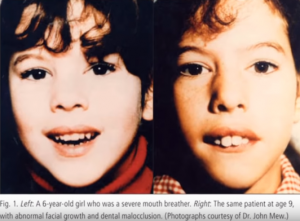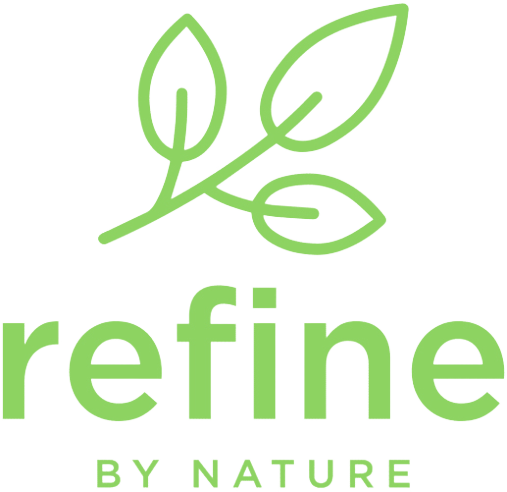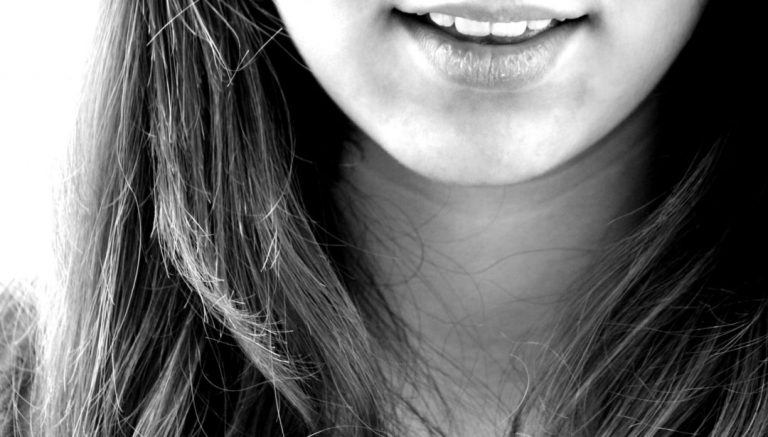If you look like Napoleon Dynamite when you breathe, then this post is for you!

It’s perfectly natural to breathe through your mouth sometimes: for example, when you’re working out or you have a cold. But if you’ve become a habitual mouth breather, you may want to consider stopping this bad habit.
Why? Aside from the chronic health problems it can bring, breathing through your mouth can actually change the shape of your face and your appearance. This is especially true for children because they’re still growing. Untreated mouth breathing can lead to abnormal facial and dental development.
The effects of proper breathing habits were first noted in observations of early Native Americans, who were known for their chiseled jaws and beautiful teeth. These physical attributes were thought to be directly related to the fact that Native Americans had learned from childhood to breathe through their nose.
This theory was scientifically proven more recently in tests using monkeys. Monkeys that had their noses plugged and had to breathe through their months began to show changes in their facial development.
What Is The Cause of Mouth Breathing?
Mouth-breathing often starts in childhood and may result from certain health disorders such as allergies and enlarged tonsils. If not corrected, the habit can continue to change a person’s face throughout their life.
Depending on the extent of the problem, the chin may continue to recede the jaw and cheeks. As this occurs, the tissue can, over time, change the shape of the nose. Mouth-breathing can even have adverse effects on the straightness of the teeth by bringing about changes in the tongue and jaw.
What Are The Side Effects Of Mouth Breathing?
Using the mouth for breathing disrupts our natural body mechanics. It can affect a number of bodily functions and lead to symptoms such as:
- Headaches
- Gingivitis and gum disease
- A sore throat and cold symptoms
- Bad breath and higher risk for cavities
- Poor sleep—leading to chronic fatigue
- Digestive disturbances—gas, upset stomach, acid reflux, etc.producing, bacterial infections and reducing a person’s oxygen supply.
The inhaling and exhaling of air through the mouth has been linked to physical changes in the face.
Physical Side Effects of Mouth Breathing:
- Long, narrow faces and mouths
- Less defined cheekbones
- Small lower jaws
- “Weak” chin
How Does Mouth Breathing Change The Shape Of A Face?
Mouth breathing causes the mouth to grow forward and downward. In turn, this growth can cause the face to sag and the chin to recede. The proper development of the airway is thus necessary when it comes to maintaining proper “oral posture” and preventing these physical changes.

The picture above shows that the normal growth of the face is forward, and this growth is achieved through proper oral posture, which is the pressure exerted by the tongue as it rests in the roof of the mouth.
A mouth-breathing person doesn’t rest their tongue on the roof of their mouth, thus the jaws can’t be properly shaped by the tongue. Furthermore, the natural forward growth of the jaws is impeded, resulting in flattened cheeks and jaws that are set back from their ideal position, compromising airflow.
Not only does mouth breathing cause a physical change in the facial development; such breathing also adversely affects body posture.
In the mouth breather, the head is tilted backward, so the weight of the head shifts toward the back of the skull. If a person can correct their head position by establishing nasal breathing, then the skull will be able to grow with a more favorable pattern. This improved growth pattern will be reflected throughout the skull, including the dental arches.
Habitual breathing through the nose is a must for correct development of the jaws, face, and airways. Breathing through the nose, with the tongue resting on the roof of the mouth, helps establish the ideal conditions for normal facial development. The practice of breathing through the mouth can eventually reduce the size of the airway due to changes in the jaw, leading to obstructive sleep apnea.

For correct skull and facial growth to take place, early intervention to establish nasal breathing and tongue posture is essential. The negative effects of mouth breathing on the structure of the jaws and face will have the most impact when they occur before puberty, so there’s only a brief window of opportunity to prevent significant changes in facial structure.
How To Stop Mouth Breathing
I know it may not be easy for everyone to breathe through their nose, but I’ve compiled some tips to help you change your mouth breathing habit.
1. Use Nasal Dilator Strips
If you have a very narrow nose then you may be prone to have flimsy nostrils. You can test if you have flimsy nostrils by taking both index fingers and pressing them just beside your nostrils on your cheek. Firmly press on your cheeks, lift skin upwards and sideways, pointing towards the outer corners of your eyes. Take a deep breath in.If you can breathe much better through your nose then you may benefit from using nasal dilator strips at night.
Another way of treating this condition is to use various internal dilators, such as Nozovent, Breathewitheez, and nasal cones, that you can find over the counter.
2. Try saline sprays and an neti pot
You can moisten your nasal passages for easier breathing by using a simple, inexpensive bottle of saline that puts out a fine mist. More sophisticated methods include aerosol saline sprays and even the Waterpik machine (you can buy a nasal adaptor for this).
Another popular way to soothe dry nasal passages is with a neti pot, which uses gravity to flush saltwater through your nose and sinuses. You can either use prepared saline packages or mix your own recipe (1 cup of lukewarm water, 1/2 teaspoon of sea salt or Kosher salt, and a pinch of baking soda).
Whatever method you use to clean and moisten the inside of your nose, use it frequently for best results. Saline removes mucus, pollutants, and allergens while also acting as a mild decongestant.
3. 3. Stop eating 3 hours before bed
If you go to bed with a full stomach, undigested food and stomach juices can leak into your throat and nose. Acid reflux not only can prevent a good night’s sleep but also can causing inflame the esophagus and nasal passages. In addition, because many people at least occasionally stop breathing while they’re asleep, a vacuum effect can occur in the throat and actively suction stomach juices up into your throat and nose.
4. Avoid drinking alcohol close to bedtime
Alcohol irritates the stomach and relaxes your throat muscles as you sleep, both of which aggravate the acid reflux described above.
5. Remove allergies in your room
If you have any known allergies, especially in your bedroom, try to either remove it or lessen your exposure to it. Learn how to remove allergies in your bedroom.
6. Get regular exercise outdoors.
Personally, I prefer an outdoor workout over the gym any day. Plus oxygen concentration tends to be lower indoors because of the buildup of carbon dioxide and other gases.
When you work out outdoors, not only are you exercising your heart and your muscles; you’re also exercising the nervous system in your nose. Vigorous physical activity activates your sympathetic nervous system, which constricts the blood vessels that supply the small bones inside your nostrils. Constricted blood vessels help you breathe better through your nose, with all the added benefits described in my previous article.
7. Relax
Lastly, slow down and relax. Modern society has all but eliminated rest breaks. Along with information overload and constant stimulation, going nonstop all day only adds to the increased stress levels that everyone experiences.
In between major activities, take a minute or so to stop what you’re doing, stretch, get up, move around, and do some deep-breathing exercises. Stress can tense up the muscles, causing you to breathe more shallowly, which causes physiologic changes that can ultimately worsen nasal congestion.
These seven simple steps won’t help everyone, but if you can apply as many of them as possible, you should notice some improvement in your ability to breathe through your nose. If you’ve tried all these steps and still can’t breathe through your nose, then seek medical help. An otolaryngologist (ear, nose, and throat doctor, or ENT) is the best doctor to manage this condition.
How To Correct Your Tongue Posture – Aka, Mewing.
So, genetics and plastic surgery aren’t the only factors in facial development. There’s a way to correct your tongue posture by something known as “mewing.” Although you shouldn’t expect miracles, mewing can really help correct mouth breathing, which will in turn improve your facial structure.
The following video gives a short but clear explanation of mewing:
As babies, we were meant to eat hard foods to develop the jaw properly and, more importantly, widen the palate. Good jaw development and a roomy palate encourage the tongue–roof of mouth posture, in which the tongue acts as a support beam for normal facial development.
As babies, we were meant to eat hard foods to develop the jaw properly and, more importantly, widen the palate. Good jaw development and a roomy palate encourage the tongue–roof of mouth posture, in which the tongue acts as a support beam for normal facial development.
As babies, we were meant to eat hard foods to develop the jaw properly and, more importantly, widen the palate. Good jaw development and a roomy palate encourage the tongue–roof of mouth posture, in which the tongue acts as a support beam for normal facial development.

Chances are you’re reading this and thinking to yourself, It’s too late to implement these changes. Luckily, that’s not true at all!
Between children and adult, the difference between bone malleability is that when you reach adulthood bone density increases, which means bone changes are much slower but still consistently over time will show improvements.
When you reach maturity, your bones do become denser and less malleable. There’s no nonsurgical solution for creating model-like facial structure. But bone changes can still occur over time to the point of noticeable facial improvements—as long as you remember the following three factors in proper tongue posture.
Steps For Correct Tongue Posture:
- Teeth together
- Lips together
- Tongue on the roof of the mouth and don’t mouth breathe!
Smile as wide as you can and then swallow to force the tongue toward the roof of the mouth. Next, push your tongue upward from this position, ensuring the back part of the tongue is in firm contact with the soft palate.
Don’t be discouraged if you can’t fit your full tongue on the roof of your mouth. If you have a narrow palate, you’ll cut off your airway when trying to flatten your tongue against the back third of your palate. With time, your palate will expand and your airway will open up.

Don’t be discouraged if you can’t fit your full tongue on the roof of your mouth. If you have a narrow palate, you’ll cut off your airway when trying to flatten your tongue against the back third of your palate. With time, your palate will expand and your airway will open up.








